Coronavirus (COVID-19): modelling the epidemic (issue no.91)
Latest findings in modelling the COVID-19 epidemic in Scotland.
Coronavirus (Covid-19): modelling the epidemic in Scotland (Issue No. 91)
Background
This is a report on the Scottish Government modelling of the spread and level of Covid-19 in Scotland. This updates the previous publication on modelling of Covid-19 in Scotland published on 17th February 2022. The estimates in this document help the Scottish Government, the health service and the wider public sector plan and put into place what is needed to keep us safe and treat people who have the virus.
This edition of the research findings focuses on the epidemic as a whole, looking at estimates of R, growth rate and incidence as well as local measures of change in the epidemic.
Key Points
- The reproduction rate R in Scotland is currently estimated as being between 0.9 and 1.1, as at 8th February 2022. The lower and upper limits have increased since last week.
- The daily growth rate for Scotland is currently estimated as between ‑2% and 1% as at 8th February. The lower limit has increased since last week.
- The number of new daily infections for Scotland is estimated as being between 252 and 498 as at 8th February, per 100,000 people.
- Average contacts from the most recent Panel B cohort of the Scottish Contact Survey (week ending 16th February) indicate an average of 5.0 contacts. This has remained at a similar level compared to the previous Panel B of the survey (week ending 2nd February).
- Mean contacts have decreased within the work and other setting (contacts outside home, school and work) by 41% and 7% respectively within the last two weeks. Contacts within the home have remained at a similar level over the same period.
- Those within the 30-59 reported an increase in mean contacts within the last two weeks by at least 13%. All remaining age groups reported a reduction in contacts over the same period, with the 18-29 decreasing the most by 19%. This decrease was largely driven by fall in mean contacts within the workplace.
- The biggest decrease in interactions between age groups is between those aged 18-29 with individuals under 18.
- The biggest change in the proportion of people visiting different locations is seen in those visiting a gym, up from 16% to 19% in the last two weeks.
- The proportion of contacts reported to have been indoors only has reached its highest recorded since the start of the Scottish Contact Survey, at 76%.
- The number of people wearing a face covering where they have at least one contact outside of the home has remained at a similar level in the last two weeks, currently at 83%.
- Approximately 79% of individuals had taken at least one lateral flow test within the last 7 days.
- Approximately 23% of individuals believe they have had Covid-19 at least once since March 2020.
- Modelled rates of positive tests per 100K using data to 21st February indicate that, for the week commencing 6th March 2022, all 32 local authorities are expected to exceed 50 cases per 100K with at least 75% probability. These local authorities are also expected to exceed 100 cases per 100K with at least 75% probability.
- 26 of the 32 local authorities are expected to exceed 300 cases per 100K, with at least 75% probability. The exceptions are Dumfries & Galloway, East Ayrshire, Na h-Eileanan Siar, North Ayrshire, Scottish Borders and South Ayrshire.
- Five local authorities are expected to exceed 500 cases per 100K, with at least 75% probability. These are Aberdeenshire, Angus, Highlands, Orkney Islands and Shetland Islands.
- Analysis indicates that there remains a substantial variation in risk of infection by age. Deprivation in this period is not a substantial factor.
- The distribution of lateral flow/LFD tests being reported continues to vary substantially by both age and deprivation status, with many fewer tests reported in younger adults across all deciles of deprivation, and for children in more deprived deciles. The high level of LFD positivity in the latter category is marked, and when compared to the high number of positives amongst the least deprived, suggests this may reflect under ascertainment.
- Nationwide, wastewater Covid-19 RNA levels did not continue the upturn seen last week. The week ending on 21st February saw levels of around 76 million gene copies per person per day (Mgc/p/d), somewhat lower than 90 Mgc/p/d the previous week.
- In this research findings we also include a new section looking at what may happen in the future around Covid-19 using a range of plausible scenarios.
Recent cases
Figure 1 shows the number of Covid-19 cases (from either PCR or LFD) in Scotland between January and February 2022. The vertical dashed lines indicate the cut off points for each of the modelling inputs; after these dates, the number of cases is not incorporated into the outputs.
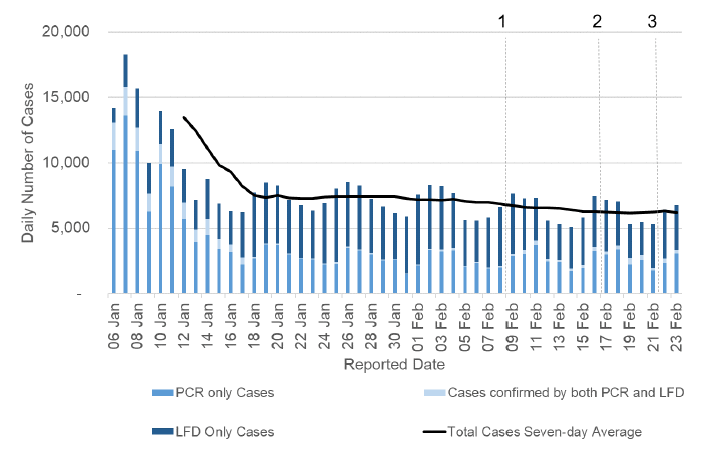
R, growth rate and incidence are as of 8th February 2022 (dashed line 1). The Scottish Contact Survey uses data to 16th February 2022 (dashed line 2). The modelled rates of positive tests per 100K and the wastewater analysis use data to 21st February (dashed line 3).
Overview of Scottish Government Modelling
Modelling outputs are provided here on the current epidemic in Scotland as a whole, based on a range of methods. Because it takes a little over three weeks on average for a person who catches Covid-19 to show symptoms, become sick, and either die or recover, there is a time lag in what our model can tell us about any change in the epidemic.
This week the Scottish Government presented two outputs to EMRG.
The first uses the number of positive LFD or PCR tests, as published by PHS Scotland. The second uses wastewater data. These outputs are included in Figures 2 and 3.
The R value and growth rates are estimated by several independent modelling groups based in universities and the UKHSA. Estimates are considered, discussed and combined at the Epidemiology Modelling Review Group (EMRG), which sits within the UKHSA. These are based on data to 21st February.
UKHSA's consensus view across these methods was that the value of R in Scotland[2] is between 0.9 and 1.1, as of 8th February 2022[3] (Figure 2). R is an indicator that lags by two to three weeks.
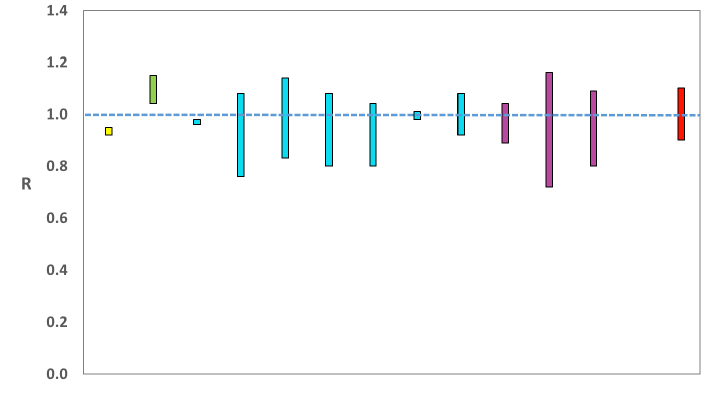
Source: EMRG
The various groups which report to the EMRG use different sources of data in their models to produce estimates of incidence (Figure 3). UKHSA's consensus view across these methods, as at 8th February, was that the incidence of new daily infections in Scotland was between 252 and 498 new infections per 100,000. This equates to between 13,800 and 27,200 people becoming infected each day in Scotland.
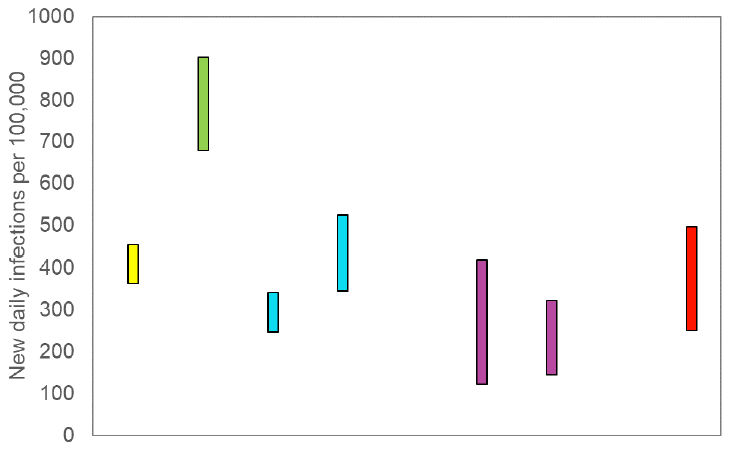
Source: EMRG
The consensus from UKHSA for this week is that the growth rate in Scotland is between -2% and 1% per day as at 8th February. The lower limit has increased since last week.
What we know about how people's contact patterns have changed
Average contacts from the most recent Panel B cohort of the Scottish Contact Survey (week ending 16th February) indicate an average of 5.0 contacts. This has remained at a similar level compared to the previous Panel B of the survey (week ending 2nd February), as seen in Figure 4. Mean contacts have decreased within the work and other setting (contacts outside home, school and work) by 41% and 7% respectively within the last two weeks. Contacts within the home have remained at a similar level over the same period but contacts within the school setting have almost tripled in the last two weeks.
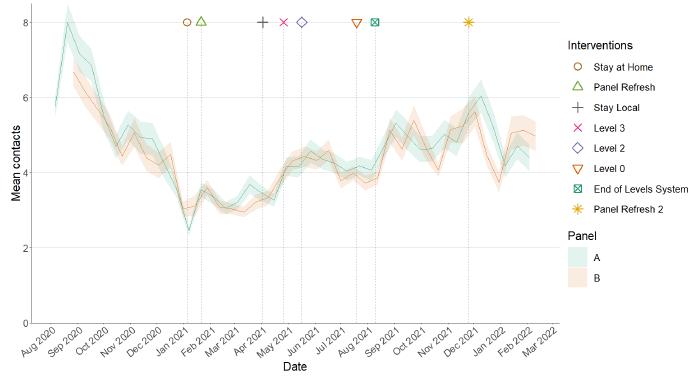
Figure 5 shows how contacts change across age group and setting. Those within the 30-59 age group reported an increase in mean contacts within the last two weeks by at least 13%. All remaining age groups reported a reduction in contacts over the same period, with the 18-29 age group decreasing the most by 19%. This decrease was largely driven by a fall in mean contacts within the workplace.
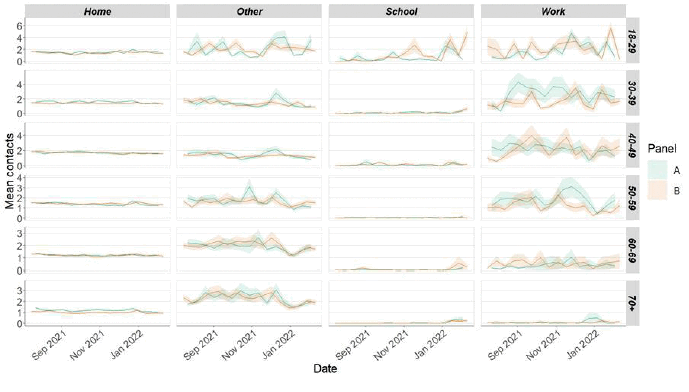
The heatmaps in Figure 6 show the mean overall contacts between age groups for the weeks relating to 27th January - 2nd February and 10th February - 16th February, and the difference between these periods. The biggest decrease in interactions between age groups is between those aged 18-29 with individuals aged under 18.
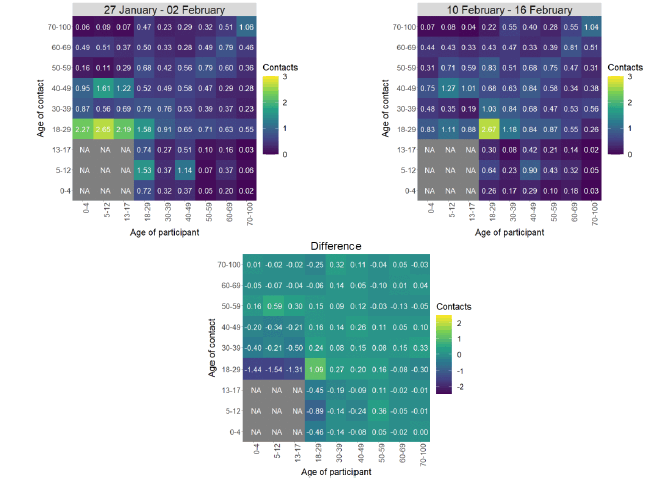
As shown in Figure 7, there has been little change in the number of participants visiting settings in the last two weeks. The biggest change is seen in the proportion of people visiting a gym, up from 16% to 19% in the last 2 weeks.
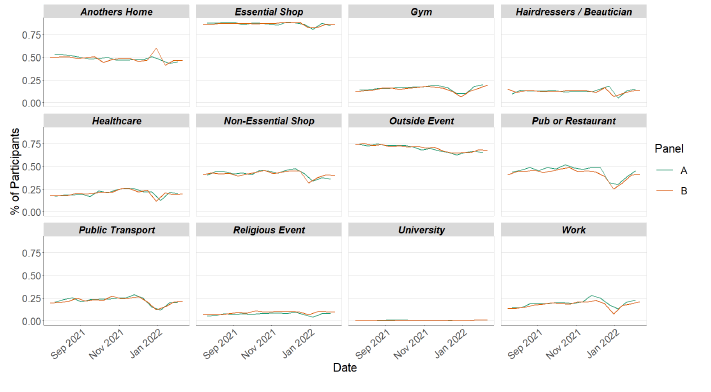
Figure 8 shows the proportion of participants that reported indoor and outdoor for contacts for panel A. A contact can also be recorded as both indoor and outdoor. The proportion of contacts reported to have been indoors only has reached its highest recorded since the start of the Scottish Contact Survey, at 76%
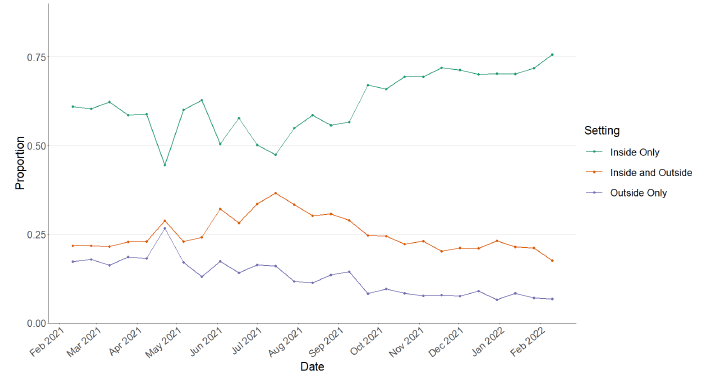
Figure 9 shows the number of people wearing a face covering where they have at least one contact outside of the home. This has remained at a similar level in the last two weeks, currently at 83%.
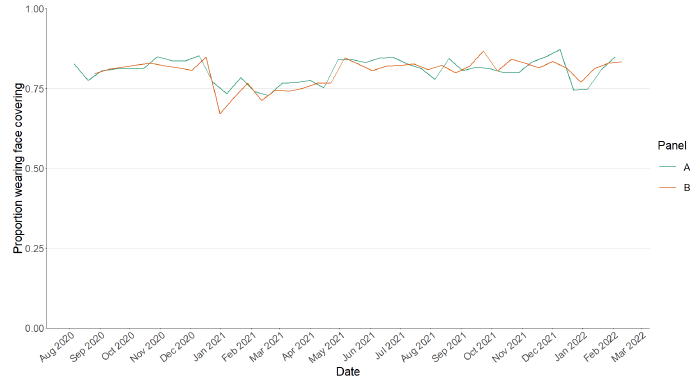
Approximately 79% of individuals had taken at least one lateral flow test within the last 7 days for the survey pertaining to the 10th February - 16th February, increasing from 74% two weeks prior as shown in Figure 10.
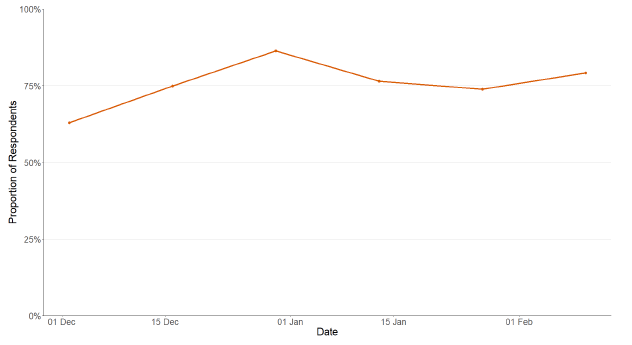
Figure 11 shows that approximately 23% of individuals believe they have had Covid-19 at least once since March 2020. Of those who think they have had Covid-19, 75% have had this confirmed through a test.
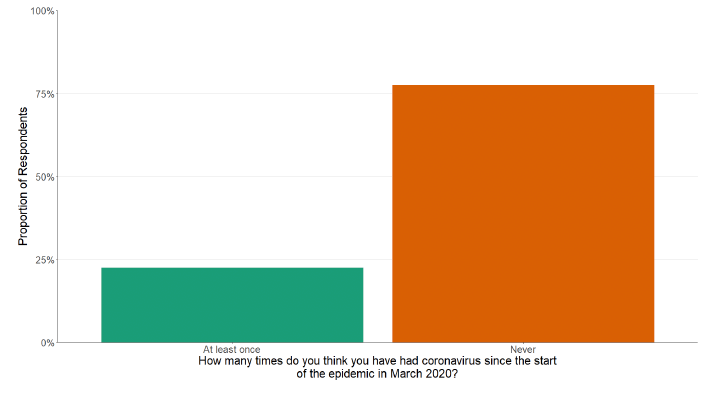
Medium-term projections
Due to the different timings of the publication of Scottish data streams, SPI-M-O has been unable to produce a consensus for hospital admissions and deaths in Scotland over the next four weeks. A change in data trend between Friday 18th February and Monday 21st February affected the individual modelling outcomes, and so different projections were outputted depending on the time in which the data was downloaded. SPI‑M‑O will look to produce projections for Scotland again next week.
In the absence of the SPI-M-O consensus we have not been able to corroborate the Scottish Government's Medium Term Projections and will therefore look to produce these projections again from next week.
What we know about which local authorities are likely to experience high levels of Covid-19 in two weeks' time
We continue to use modelling based on Covid-19 cases and deaths using data to 21st February 2022 from several academic groups to give us an indication of whether a local authority is likely to experience elevated levels of Covid-19 in the future. This has not been compiled via UKHSA into a consensus this week and is based on one modelling group due to issues with some of the models converging. In this an area is defined as a hotspot if the two-week prediction of cases (positive tests) per 100K population is predicted to exceed a threshold, e.g., 500 cases.
Some of the models contributing to this analysis are informed by both PCR and LFD positive tests whilst others are currently informed by PCR only.
Modelled rates of positive tests per 100K using data to 21st February (Figure 12) indicate that, for the week commencing 6th March 2022, all 32 local authorities are expected to exceed 50 cases per 100K with at least 75% probability. These local authorities are also expected to exceed 100 cases per 100K with at least 75% probability.
26 of the 30 local authorities included are expected to exceed 300 cases per 100K, with at least 75% probability. The exceptions are Dumfries & Galloway, East Ayrshire, Na h-Eileanan Siar, North Ayrshire, Scottish Borders and South Ayrshire.
Five local authorities are expected to exceed 500 cases per 100K, with at least 75% probability. These are Aberdeenshire, Angus, Highlands, Orkney Islands and Shetland Islands.
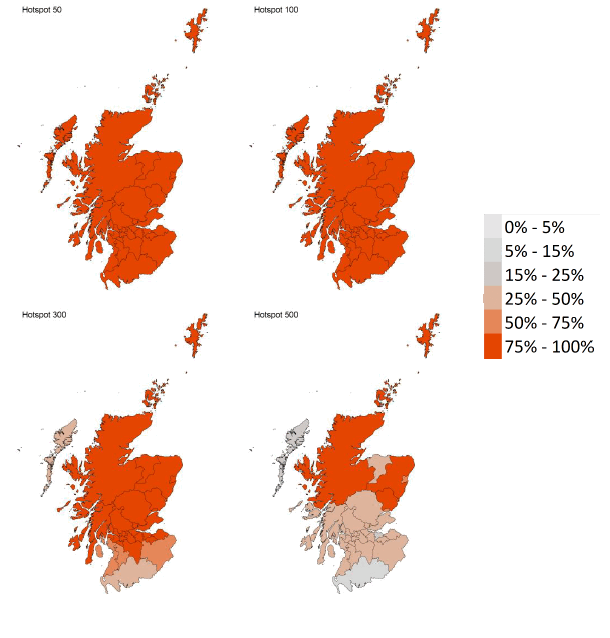
Looking to the future
What may happen in the future around SARS-CoV-2 is uncertain and therefore there are a number of possible Covid-19 futures that may occur in the future. For example, the current Omicron wave may dissipate leaving low levels of Covid-19, or a new variant may emerge potentially having vaccine escape or increased severity, or people's behaviours may change. One approach to this uncertainty is to model alternative versions of the future through the development of different Covid-19 scenarios. See the Technical Annex for more details on how we do this modelling.
This analysis was included in our recent evidence paper accompanying the Scottish Government's strategic framework[5]. We repeat this analysis here and will update in future publications.
Given what we know about Covid-19 these possible futures range from a world where immunity reduces Covid-19 hospitalisations and deaths to low levels, through to variant world where a variant with immune escape enters Scotland and Covid-19 hospitalisations and deaths could increase. In between these two extremes could be possible futures where vaccine effectiveness wanes or where people's behaviour becomes polarised between those who continue with Covid-19 precautions e.g. hand washing etc. and those who do not (see Figure 13).
The scenarios we provide in the next section look at what could happen for planning purposes, not to forecast what will happen. These scenarios include no changes from the current baseline measures. The assumptions are based on our most up to date knowledge, but do not include the effect of future changes in treatment of Covid-19 e.g. widespread use of antivirals or changes in behaviour in response to high levels of infections e.g. in variant world. Therefore, in the most extreme scenarios the peak may be lower than suggested if behaviour or restrictions changed.
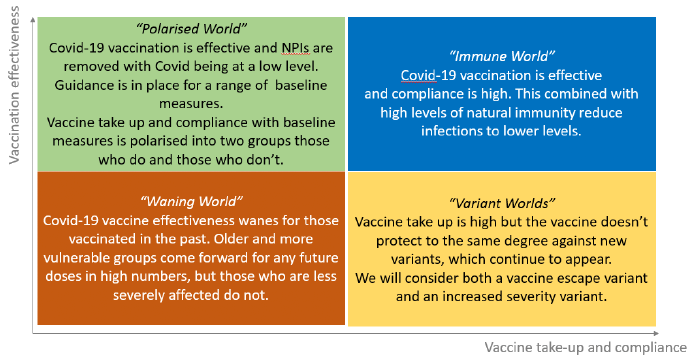
There is no linear progression between the worlds and all are plausible. Each world inherently contains a different threat level requiring a different approach to management.
Immune World
In this possible future vaccines and natural immunity are effective at keeping Covid-19 at low levels. Baseline measures and LFD testing are in place to protect the vulnerable e.g. elderly and immune compromised and adhered to by the public to high levels. New variants may emerge in Scotland but for the foreseeable future infections are based around Omicron.
Infections may decrease from current levels over the coming weeks and months to very low levels. Likewise hospital and ICU occupancy may follow this trend relieving the pressure on healthcare services. Issues with vaccine waning and new variants are not considered in this world and therefore levels of infections remain low (<1,000 per day).
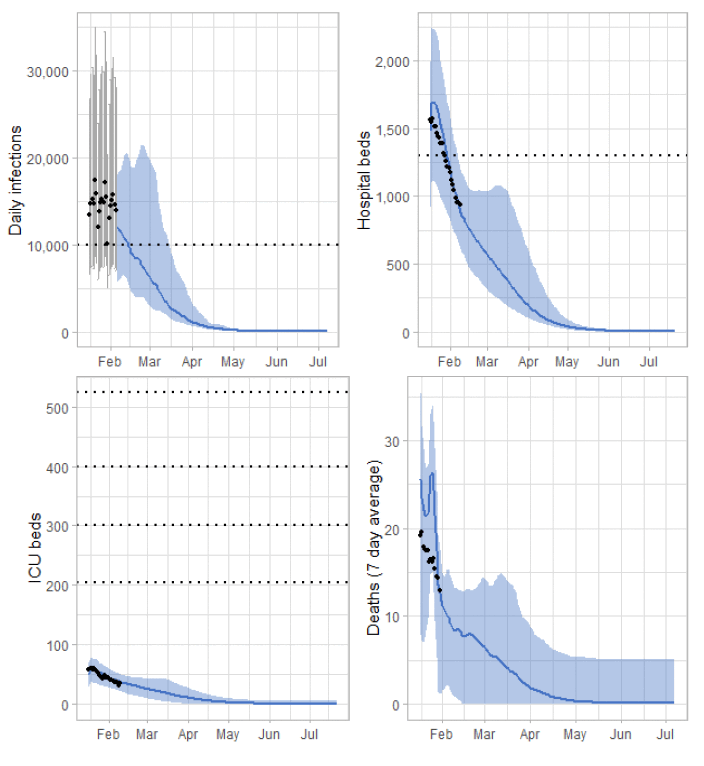
In Immune world Covid-19 in Scotland reduces below epidemic levels, becoming endemic. Cases of Covid-19 therefore spring up only as rare outbreaks which are controlled through public health measures. People's lives return to something close to normality e.g. physical distancing is not needed but people still choose to self-isolate and hygiene is good. As vaccines are effective, take-up of first/second/third doses are good and boosters become part of an annual cycle like flu. The numbers of people who need medical treatment or hospitalisation for Covid-19 remain low.
The focus moves away from Covid-19 response and into recovery. This includes addressing learning losses, treating Long Covid and working through the hospital backlog. Wellbeing measures improve with reduced anxiety and increased happiness. Those from the highest risk groups feel they can reintegrate without government interventions. The economy begins to recover from the effects of Covid-19. Travellers do not face significant issues with trips overseas.
Waning world
In this world Covid-19 vaccines are effective over several months, but waning then occurs. It is hard to keep pace with booster vaccinations which become increasingly difficult to justify. Demands for vaccines throughout the rest of the world and the increasing reluctance of people in Scotland to keep being boosted reduces the overall immunity levels of the population.
Infections may not substantially decrease from current levels initially before falling in March as the natural immunity begins to offset the waning of vaccine acquired immunity.
Impacts on hospital/ICU occupancy and deaths are uncertain. While at relatively low levels infections may be between 500 – 2,000 per day by summer. These levels would be higher than has been observed in summer 2020 and 2021 and higher than what may happen in immune world (see Figure 15).
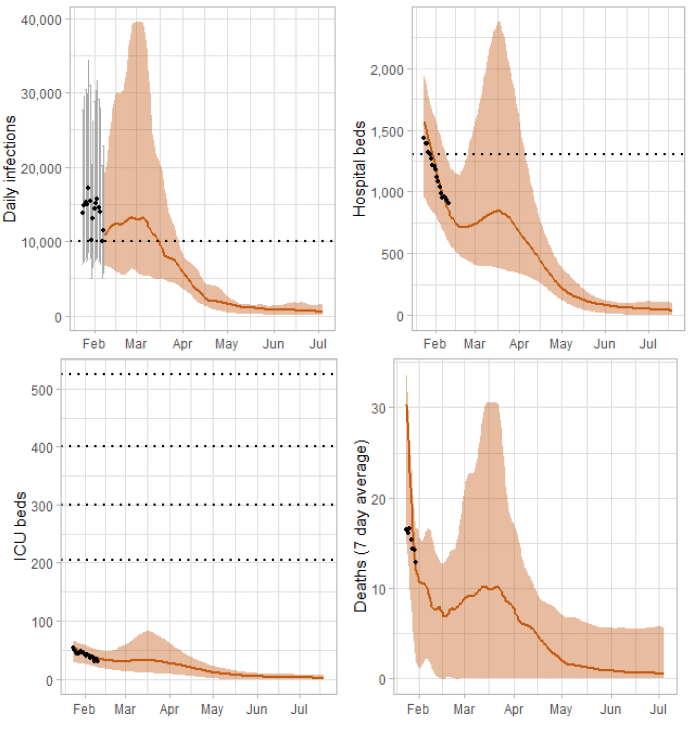
The number of people who need medical treatment or hospitalisation for Covid-19 rises particularly in vulnerable/older age groups where it is increasingly difficult to deliver an effective booster regime.
The focus continues to be on Covid-19 response and it is harder to shift on to recovery. Hospitals are still dealing with increasing cases of Covid‑19 putting pressure on healthcare services and workforce which also puts pressure on other public services and budgets. Work is ongoing on rectifying learning loss but continued cases of Covid-19 within education settings with children and staff being off school slows the effectiveness of this work.
The population becomes segmented as the most vulnerable due to vaccine waning lead restricted lives or accept significant risk of serious illness and experience high levels of anxiety and low levels of wellbeing. The rest of the population live a more normal life accepting the possibility of infection with mild illness. Anxiety reduces but does not disappear, likewise wellbeing increases but there is still concern about infection. The economy continues to be impacted by workforce absences, the self-shielding actions of a proportion of the population and risk adverse behaviours.
Polarised world
In this world, vaccines and natural immunity are effective at reducing infections. Baseline guidance remains in place, with face coverings, physical distancing and some testing. The approach followed relies on individual risk assessment and behaviours. However society becomes polarised as some continue to take up vaccines and follow guidance while others are more reluctant. Covid-19 becomes a disease associated with those who do not or cannot get full vaccine benefit and do not or cannot adopt a risk based approach maintaining baseline measures.
Infections may decrease from current levels over the coming weeks and months to low levels but more slowly than in other scenarios due to various groups behaving differently across society.
This world assumes that infections continue to decrease in the coming weeks with behavioural changes beginning to occur in response to this and to the better weather from March. Unvaccinated adults and those with one dose are assumed to return to pre-pandemic behaviours within six weeks. Adults with two doses are assumed to return to these behaviours over 12 weeks, with those with three doses assumed to have no significant changes in behaviour.
Vaccine waning is included in this world whereby only some of those with three doses come forward for a potential fourth dose.
While at relatively low levels infections may be between 1,000 – 5,000 per day by summer. These levels would be higher than has been observed in summer 2020 and 2021 and higher than what may happen in immune world (see Figure 16).
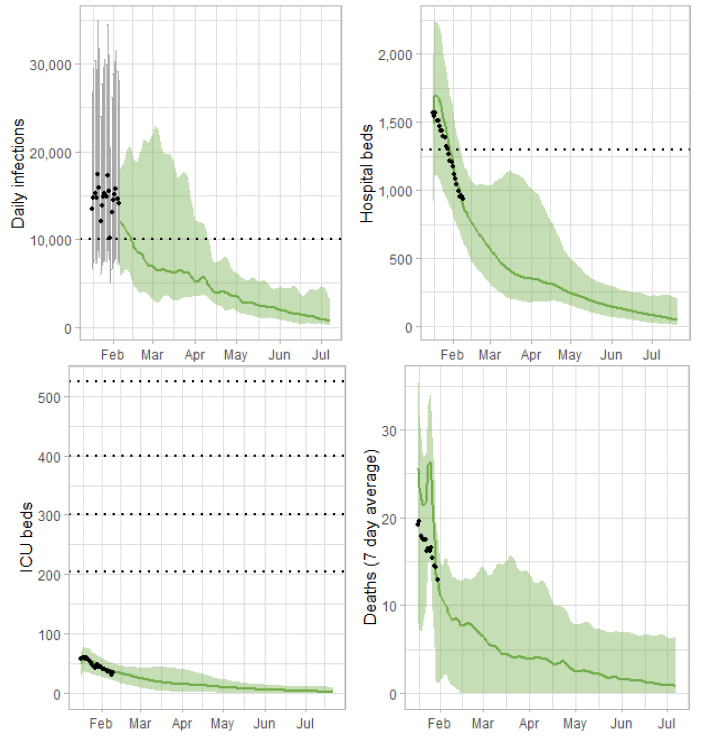
Cases of Covid-19 spring up and are hard to control in those who are not vaccinated or vulnerable. People's lives return to a "new normal" but, due to polarised groups in society with some following and some not following the guidance on baseline restrictions, infections remain.
Vaccines are effective so older and more vulnerable people come forward for future doses in high numbers but those who are less severely affected do not. Vulnerable groups such as the very elderly and immune compromised are at risk from infection from those not vaccinated or boosted.
The focus remains on Covid-19 and the shift onto recovery is slower. Existing learning losses are harder to rectify and continue to accrue due to infections within education settings. The hospital backlog is difficult to address as hospitals are still dealing with Covid-19 cases. The population becomes polarised in to those whose wellbeing improves e.g. lower risk people and those whose wellbeing deteriorates e.g. higher risk or poorer people whose levels of anxiety increase as Covid-19 circulates. They continue to experience greater illness, greater poverty or disruption to their income. The economy continues to be impacted from the effects of Covid-19. Unvaccinated travellers continue to face significant uncertainty with trips.
Variant world – vaccine escape with same severity as Delta
In this possible future a variant with vaccine escape emerges in Scotland presenting a challenge even for fully vaccinated people. This new variant leads to increased transmission, but not to increased severity. Baseline measures – face coverings, LFD, physical distancing remain and, in this scenario other NPIs may need to be put in place for a short time. This world is similar to what has happened in Scotland with the emergence of Omicron.
Omicron may be reduced to low levels within Scotland as a new variant takes over. This causes a new wave of Covid-19 infections. However this wave is not accompanied by significant numbers with serious illness and vaccines continue to protect. People's lives are disrupted due to the increasingly high levels of infections leading to time off work ill or isolating.
To show the potential impact assume a new variant appears in Scotland as people return from their summer holidays and return to work and school. The timing is uncertain and a potential new variant may appear sooner than the summer or significantly later but has currently been lined up with the summer holidays to show illustratively what could happen. The new variant may cause Omicron infections to decrease significantly or disappear entirely (Immune world has been used to illustrate this). The new variant is modelled with similar transmissibility and vaccine escape as Omicron with severity characteristics similar to Delta. It could lead to high levels of infections leading to hospital occupancy rising above capacity restrictions. With sustained high levels of infection we could again see increased staff absences in a number of sectors that were affected by this in the recent Omicron wave.
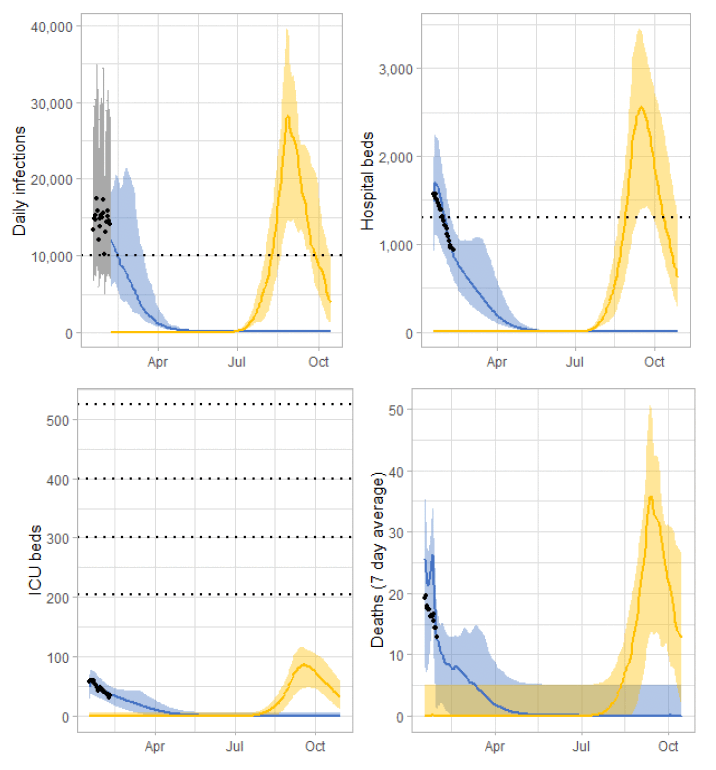
The focus remains on Covid-19 and it is hard to shift on to recovery. Continued infections within education settings and staff shortages make some school closures necessary. The Covid-19 strain on hospitals is high due to the very high numbers of infections and workforce pressures grow making it difficult to address the hospital backlog. Wellbeing measures deteriorate with people reporting low happiness and general 'tiredness with it all'. The economy continues to be impacted from the effects of Covid-19 with many people off work. Travellers may not want to come to the UK as the new variant sweeps through.
Variant world – vaccine escape with increased severity compared to Delta
As with the other example of Variant world, a new variant appears in Scotland as people return from their summer holidays and return to work and school. The timing is uncertain but has currently been lined up with the summer holidays where reduced travel restrictions may make it more likely that a new variant is brought into Scotland.
The new variant may cause Omicron infections to decrease significantly or disappear entirely. It is modelled with similar transmissibility and vaccine escape as Omicron with severity characteristics 50% higher than Delta, purely for illustrative purposes.
It could lead to high levels of infections leading to hospital occupancy rising well above capacity restrictions. With sustained high levels of infection we could again see increased staff absences in a number of sectors that were affected by this in the recent Omicron wave.
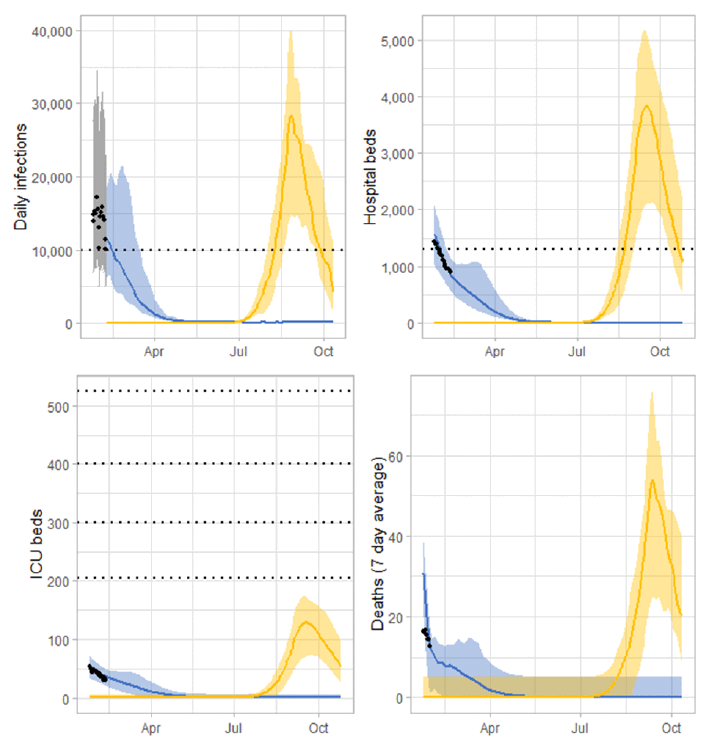
Background levels of Covid-19
In each of these possible futures there will be a background level of Covid-19 to plan for and manage. When comparing the worlds, Figure 19 shows the period May to September and what the background levels may look like. This ranges from under 1,000 Covid-19 infections in Scotland per day to over 5,000 in May, potentially dropping to below 2,500 in August. If a new variant appeared it could be substantially higher. Depending on this background level of Covid-19 different levels of pressure will be put on the public sector in Scotland as different numbers of people become sick and need medical treatment.
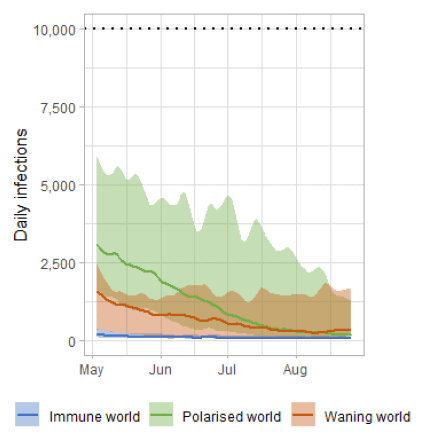
The four worlds plausible scenarios as presented in this section should not be considered predictions. It is difficult to ascertain which of these scenarios may be the more likely and in reality the situation is likely to move from one to the other and not in a linear fashion. Instead they provide some illustration of what each world could look like and the issues to be considered. Over the coming months they will be updated as circumstances change to support ongoing planning and management of the pandemic.
Summary of spatial analysis of Covid-19 spread in Scotland
Researchers at the Edinburgh Roslin Institute have conducted spatial analysis of Covid-19 Spread in Scotland. A summary of findings from the week from 16th February to 22nd February 2022 is included here.
In the period 16th February to 22nd February, an S-Gene Target Failure (SGTF) PCR result is assumed to be due to Omicron variant BA.1. In Scotland a test which is S-gene positive is taken to be a signature of Omicron variant BA.2, while acknowledging there may be some residual Delta variant cases contributing. To obtain estimates of the total spread of the two variants, we assign variant type in proportion to the observed SGTF results per day at the Local Authority level.
The modelling shows there remains a substantial variation in risk of infection by age. Deprivation in this period is not a substantial factor when comparing across local authorities. Risk factors remain stable, when comparing to previous weeks.
The distribution of lateral flow/LFD tests being reported varies substantially by both age and deprivation status, with many fewer tests reported in younger adults across all deciles of deprivation, and for children in more deprived deciles. The high level of LFD positivity in the latter category is marked, and when compared to the high number of positives amongst the least deprived, suggests this may reflect under ascertainment.
Numbers of PCR and LFD tests are both declining, but positivity is increasing suggesting some evidence of under-ascertainment.
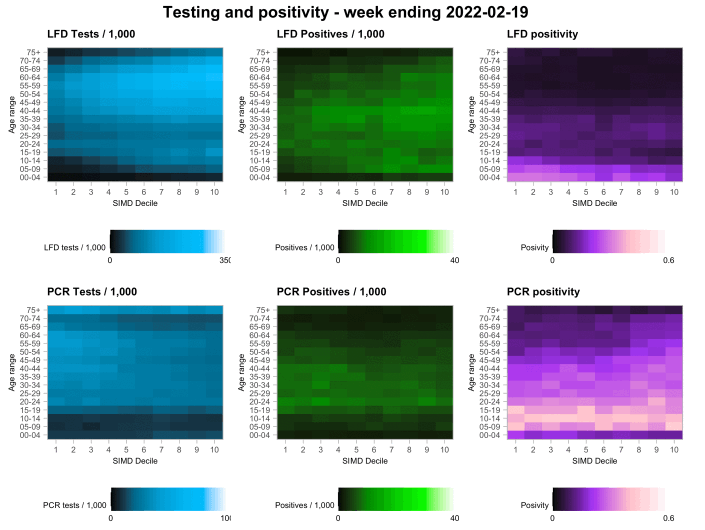
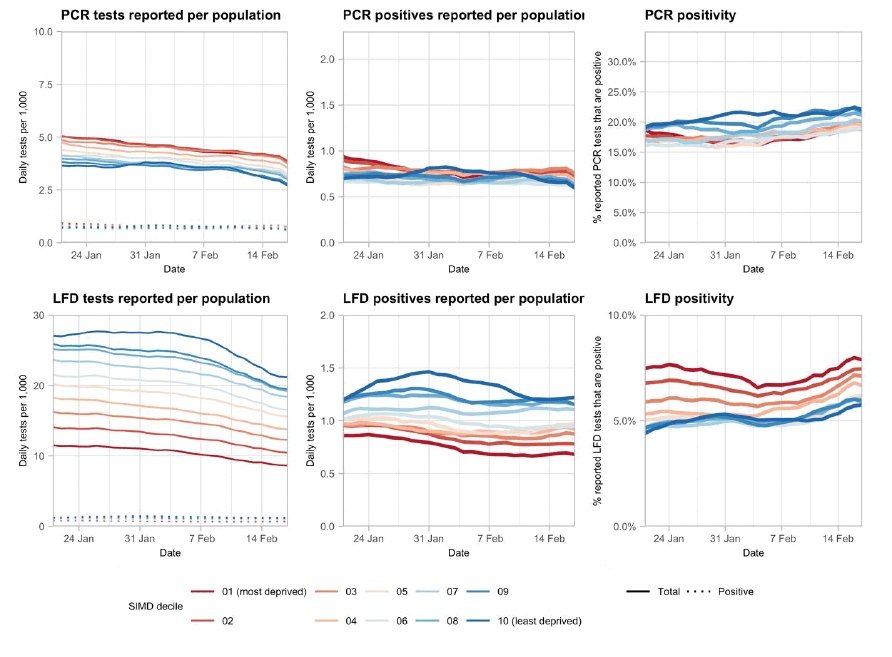
What can analysis of wastewater samples tell us about local outbreaks of Covid-19 infection?
Levels of Covid-19 RNA in wastewater (WW) collected at a number of sites around Scotland are adjusted for population and local changes in intake flow rate (or ammonia levels where flow is not available). See Technical Annex in Issue 34 of these Research Findings for the methodology.
Nationwide, wastewater Covid-19 RNA levels did not continue the upturn seen last week. The week ending on 21st February saw levels of around 76 million gene copies per person per day (Mgc/p/d), somewhat lower than 90 Mgc/p/d the previous week (week ending 14th February).
In Figure 22, we restrict the plotting to the period after the end of 2021, at which point S-gene dropout testing data suggest that nearly all cases are from the Omicron variant. In this period WW testing should have a consistent relationship with Covid-19 prevalence, assuming that the change in relationship is due to the new dominant variant and there is no shedding difference with the Stealth variant BA.2. In this more restricted graph, we see a flat trend in WW levels followed by a recent increase and little change over the last week. We also superimpose data from the ONS Coronavirus Infection Survey (CIS), with scaling chosen to match case and wastewater trends last year. This shows Covid-19 levels also appearing to level off.
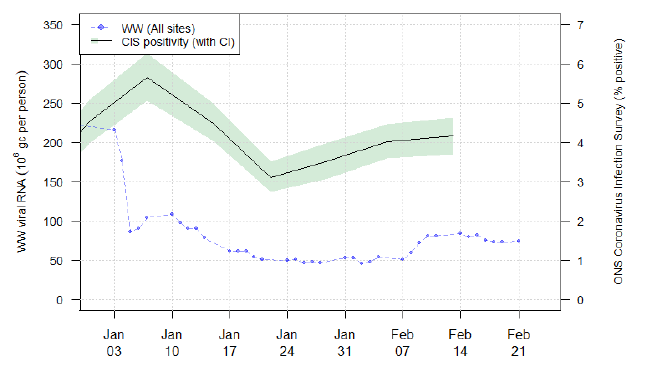
Analysis (not shown here) suggests that LFD-based results are strongly influenced by gender, socioeconomic status, and geography. Furthermore, LFD-based results will be heavily impacted by future changes, such as the end of the provision of free LFD test kits. For these reasons, we will discontinue the use of case rate statistics in these wastewater reports. We will review the situation at a later date.
Long Covid
A report on the rate of long Covid has not been included this week. We will report the long Covid projections again once updated estimates of self-reported long Covid prevalence amongst those infected with the less severe Omicron variant become available.
What next?
Modelling will continue to look at the impact of Omicron, particularly the variant BA.2. The UKHSA Risk Assessment for BA.2 (9th February 2022) stated that there is moderate confidence that BA.2 has a growth advantage compared to BA.1, from data reported by multiple countries. As the year progresses we will incorporate different models as and when it is appropriate to do so.
We hope to include our analysis on medium-term projections and long Covid next week.
Contact
There is a problem
Thanks for your feedback